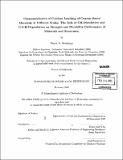| dc.contributor.advisor | Frans-Joseph Ulm. | en_US |
| dc.contributor.author | Heukamp, Franz H. (Franz Hoyte), 1973- | en_US |
| dc.contributor.other | Massachusetts Institute of Technology. Dept. of Civil and Environmental Engineering. | en_US |
| dc.date.accessioned | 2005-10-14T19:37:49Z | |
| dc.date.available | 2005-10-14T19:37:49Z | |
| dc.date.copyright | 2003 | en_US |
| dc.date.issued | 2003 | en_US |
| dc.identifier.uri | http://hdl.handle.net/1721.1/29282 | |
| dc.description | Thesis (Ph. D .)--Massachusetts Institute of Technology, Dept. of Civil and Environmental Engineering, 2003. | en_US |
| dc.description | Includes bibliographical references (p. 327-341). | en_US |
| dc.description.abstract | Calcium leaching is a durability threat for cement-based materials employed in critical infrastructures, such as Nuclear Waste Storage Systems. This thesis presents a comprehensive study of the material and structural consequences of calcium leaching on the strength and deformation behavior of cementitious materials. Starting from a three-level microstructural division of the heterogeneous microstructure of cement-based materials, a series of experimental and theoretical investigations is conducted leading to the development of a novel constitutive model and model-based simulations of the long-term mechanical performance of concrete structures subjected to calcium leaching. A chemically accelerated leaching device is developed using an ammonium nitrate solution to obtain asymptotically leached specimens in short times. An acceleration rate of 300 compared to natural leaching is obtained. The strength domain of leached cement pastes and mortars is evaluated through triaxial compression tests and uniaxial tension tests, revealing an important strength loss and an increased pressure sensitivity of the materials at failure, associated with leaching. A micromechanical approach for the homogenization of the elastic properties and the strength properties based on the three microstructural levels is developed. These developments allow estimating the relations between the microstructural changes and poroelastic properties including Biot-coefficient and Biot-modulus. In addition, upscaling schemes for the cohesion and friction properties on different levels of cement-based materials are developed. | en_US |
| dc.description.abstract | (cont.) Through this the influence of the Interfacial Transition Zone on the strength of intact and leached materials is evaluated. The micromechanical elements of the analysis are combined in a chemoporoplastic constitutive model. The porosity created by calcium dissolution (chemical porosity) is identified as a state variable, relating dissolution process and mechanical properties. The model is implemented in a commercial finite-element program, and model-based simulations show the predictive capability of the developed approach to improve the durability design of concrete structures subjected to calcium leaching. | en_US |
| dc.description.statementofresponsibility | by Franz H. Heukamp. | en_US |
| dc.format.extent | 380 p. | en_US |
| dc.format.extent | 16345201 bytes | |
| dc.format.extent | 16345001 bytes | |
| dc.format.mimetype | application/pdf | |
| dc.format.mimetype | application/pdf | |
| dc.language.iso | eng | en_US |
| dc.publisher | Massachusetts Institute of Technology | en_US |
| dc.rights | M.I.T. theses are protected by copyright. They may be viewed from this source for any purpose, but reproduction or distribution in any format is prohibited without written permission. See provided URL for inquiries about permission. | en_US |
| dc.rights.uri | http://dspace.mit.edu/handle/1721.1/7582 | |
| dc.subject | Civil and Environmental Engineering. | en_US |
| dc.title | Chemomechanics of calcium leaching of cement-based materials at different scales : the role of CH-dissolution and C-S-H degradation on strength and durability performance of materials and structures | en_US |
| dc.type | Thesis | en_US |
| dc.description.degree | Ph.D . | en_US |
| dc.contributor.department | Massachusetts Institute of Technology. Department of Civil and Environmental Engineering | |
| dc.identifier.oclc | 52255615 | en_US |
